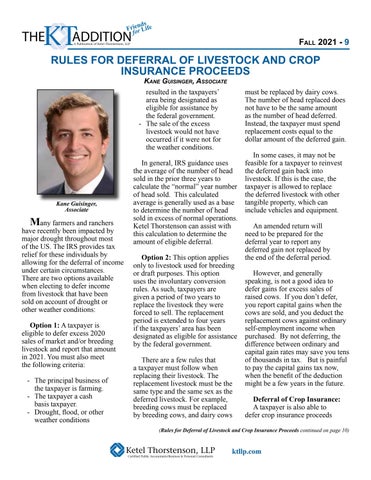Fall 2021 - 9
RULES FOR DEFERRAL OF LIVESTOCK AND CROP INSURANCE PROCEEDS Kane Guisinger, Associate
must be replaced by dairy cows. The number of head replaced does not have to be the same amount as the number of head deferred. Instead, the taxpayer must spend replacement costs equal to the dollar amount of the deferred gain.
resulted in the taxpayers’ area being designated as eligible for assistance by the federal government. - The sale of the excess livestock would not have occurred if it were not for the weather conditions.
Kane Guisinger, Associate
Many farmers and ranchers
have recently been impacted by major drought throughout most of the US. The IRS provides tax relief for these individuals by allowing for the deferral of income under certain circumstances. There are two options available when electing to defer income from livestock that have been sold on account of drought or other weather conditions: Option 1: A taxpayer is eligible to defer excess 2020 sales of market and/or breeding livestock and report that amount in 2021. You must also meet the following criteria: - The principal business of the taxpayer is farming. - The taxpayer a cash basis taxpayer. - Drought, flood, or other weather conditions
In general, IRS guidance uses the average of the number of head sold in the prior three years to calculate the “normal” year number of head sold. This calculated average is generally used as a base to determine the number of head sold in excess of normal operations. Ketel Thorstenson can assist with this calculation to determine the amount of eligible deferral. Option 2: This option applies only to livestock used for breeding or draft purposes. This option uses the involuntary conversion rules. As such, taxpayers are given a period of two years to replace the livestock they were forced to sell. The replacement period is extended to four years if the taxpayers’ area has been designated as eligible for assistance by the federal government. There are a few rules that a taxpayer must follow when replacing their livestock. The replacement livestock must be the same type and the same sex as the deferred livestock. For example, breeding cows must be replaced by breeding cows, and dairy cows
In some cases, it may not be feasible for a taxpayer to reinvest the deferred gain back into livestock. If this is the case, the taxpayer is allowed to replace the deferred livestock with other tangible property, which can include vehicles and equipment. An amended return will need to be prepared for the deferral year to report any deferred gain not replaced by the end of the deferral period. However, and generally speaking, is not a good idea to defer gains for excess sales of raised cows. If you don’t defer, you report capital gains when the cows are sold, and you deduct the replacement cows against ordinary self-employment income when purchased. By not deferring, the difference between ordinary and capital gain rates may save you tens of thousands in tax. But is painful to pay the capital gains tax now, when the benefit of the deduction might be a few years in the future. Deferral of Crop Insurance: A taxpayer is also able to defer crop insurance proceeds
(Rules for Deferral of Livestock and Crop Insurance Proceeds continued on page 10)
ktllp.com







